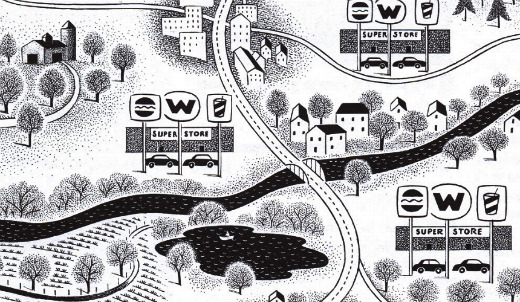Read an excerpt from this article below. You can download the full article by using the link at the end of the excerpt.
… The first and most important step is to recognize that communities can prevent the sprawl and commercial glut associated with superstores. This type of development is not inevitable. Moreover, it interferes with important public goals, such as conserving limited resources and protecting community assets — a rejuvenated downtown, for example. It also sets the stage for wasteful, duplicative public expenditures. This then makes it harder to pay for important human services.
The second step is to recognize that many local plans and zoning ordinances actually invite sprawl and retail glut and therefore need revision. Planning laws commonly promote these problems by:
- allowing huge stores in inappropriate locations, such as prime farmland or in areas not served by adequate transportation systems (that’s systems, not just roads);
- mandating parking, building setback, and other features that make it impractical for customers to reach stores except by car;
- prohibiting the intermingling of homes and stores, even when stores are small, pedestrian-oriented, well-designed structures that serve neighborhood rather than regional needs; and
- permitting more retail space than the local economy can absorb.
… Whether your town favors or opposes superstores, there is no doubt that such large developments will have a permanent, irrevocable impact on your community. Find the time necessary to make sure a project’s various effects — environmental, traffic, economic and social — are thoroughly evaluated and well understood. See Sidebar Economic Impact Study.
Some planning boards have commissioned independent studies and asked the developer to pay for them. Depending on local circumstances, this may or may not be appropriate. If you decide to commission a study, be sure to select a competent consultant, someone who understands all the ramifications of this type of development.
If for some reason your town cannot or does not want to commission an independent analysis, make sure that certain key questions get adequately addressed during public hearings:
- How much traffic will the superstore generate? (It’s not uncommon for a single superstore to generate as many as 10,000 new car trips a day.)
- How much will it cost to build and maintain new roads and water and sewer lines needed by the superstore? Who will pay? If the superstore displaces existing businesses and jobs while placing a heavier demand on police, traffic and other municipal services, what will be the net, long-term effect on the community’s tax base?
- How do the existing jobs provided by local businesses compare in terms of wages and health benefits to the jobs promised by the superstore?
- Who is the developer’s anchor tenant? The developer may argue that he is not free to disclose the tenant’s identity, but remember: different retailers generate different traffic and sales volumes. You need to know what these are in order to assess the project’s impact. …
End of excerpt
You must be logged in or a PlannersWeb member to download this PDF.
